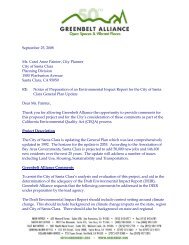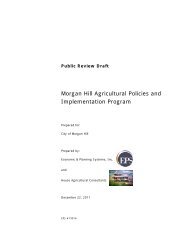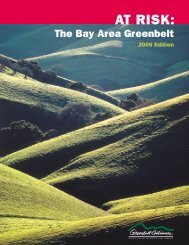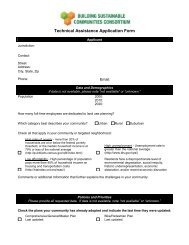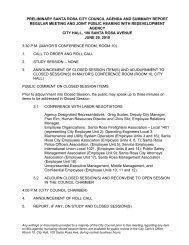Methodology - Greenbelt Alliance
Methodology - Greenbelt Alliance
Methodology - Greenbelt Alliance
You also want an ePaper? Increase the reach of your titles
YUMPU automatically turns print PDFs into web optimized ePapers that Google loves.
In-Law UnitsIncremental infill within existing neighborhoods provides a small number of homes: 4% (29,096) ofhomes created. These were included in the model because they are an important way that infill canhappen that creates minimal changes to the surrounding neighborhoods, boosts home affordabilityfor homeowners, and makes room for more socioeconomic diversity within a community.Priority Development AreasThis research incorporates local governments’ plans for infill growth. The Association of Bay AreaGovernments’ Priority Development Areas (PDAs) encompass the most intense areas of focusedinfill growth and therefore provide a significant portion of both the housing and jobs. According toestimates created by ABAG and local jurisdictions, approximately 63% of needed homes and 64%of needed jobs can be accommodated as infill in Priority Development Areas. Within the PDAs,according to the most current data available as of the time of this research, and after subtractingnon-urban PDA census tracts, over 450,000 homes and nearly 1,050,000 jobs can be accommodatedas infill.Priority Development Areas estimates are higher than the model’s projection of the infill capacitywithin those neighborhoods. PDAs appear to increase the infill potential of those neighborhoodsover the estimates achieved by opportunity sites and in-law housing units by approximately 50% inemployment and 80% in housing.The efforts of local governments are crucial, and it makes sense that these would boost local infillpotential, for several reasons. First, the infill model does not include any publicly owned land, suchas BART parking lots or military bases. The efforts of local governments can make this additionalland available. Second, targeted city activity can raise property values. This brings moreredevelopment activity. The model would show this as future updates of the assessors’ parcel datawould show more parcels falling below the 1:1 improvement-to-land value ratio and becomeeconomically viable for redevelopment.Without the city efforts and addition of public lands reflected in the PDAs, the region is unlikely tosucceed at providing the needed homes and jobs. The Bay Area could not achieve the targetsthrough profit-driven real estate activity alone. The research shows the importance of supportinglocal government activities that will encourage infill development.CONCLUSIONThis document is intended to provide the technical details that support <strong>Greenbelt</strong> <strong>Alliance</strong>’s infillresearch. The data here raises interesting questions about the growth coming to the Bay Area, thebenefits and challenges of growing in this way, and key policy changes necessary to make thispossible. Commentary on these questions are available in Smart Infill, a practical how-to guide thatalso includes key questions and answers about infill, as well as the Grow Smart Bay Area brochure andwebsite (www.growsmartbayarea.org).23






